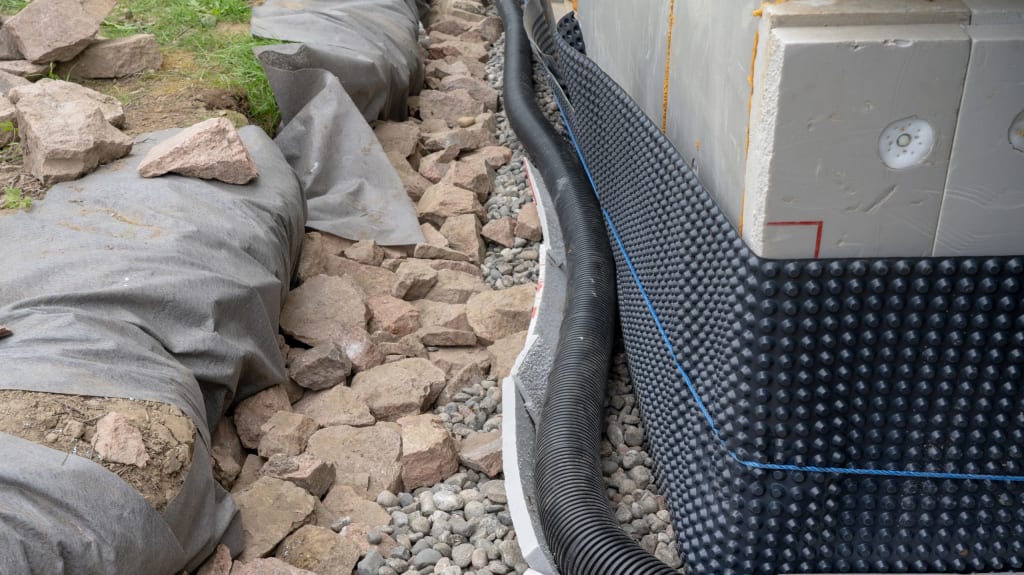A French drain has a typical lifespan of 20 to 30 years, although this can vary depending on the quality of the installation and surrounding conditions. Regular maintenance and the materials used, such as PVC or crushed stone, play an important role in prolonging its lifespan.
The factors influencing its lifespan
The average lifespan of a French drain varies according to several factors, such as the quality of the installation and the materials used in its design, local environmental conditions and regular maintenance. In general, these drainage systems can be expected to last for several decades. There are no guarantees, however, as many factors come into play.
The quality of the materials
This is crucial to the long-term operation of the French drain. Corrosion-resistant materials, such as PVC, are essential to prevent damage from groundwater and plant root intrusion. They also need to be durable to cope with the wear and tear and harsh conditions that can be caused by clay soils or ground movement, and have good permeability to ensure efficient flow through the system.
The installation technique
Correct installation of a French drain is essential to guarantee its long-term effectiveness, control the presence of moisture and prevent infiltration through the foundation. Proper work at this stage, preferably carried out by professionals, will ensure proper operation, reduce the risk of blockages and leaks, stabilize the soil and prevent structural damage associated with groundwater.
The installation process begins with planning the location and depth of the trench around the building. The trench is then dug along the foundation at an even slope. A layer of drainage material (crushed stone or gravel) is placed at the bottom, then the perforated pipe is laid, ensuring that it is aligned and inclined towards the outlet point.
It’s important to test the system with water and adjust the angle if necessary. When this is done, it’s time to backfill the trench completely with crushed stone or gravel to help absorb precipitation.
To ensure correct, long-lasting installation, call on the services of qualified professionals from RénoAssistance.
Accumulation of particles
The French drain is designed to evacuate water around the foundation of a building or other structure. When particles such as sand, mud or other debris collect in the drain, the system can become clogged and less efficient.
Excessive sediment accumulation can lead to reduced flow through the pipe, resulting in increased hydrostatic pressure and, eventually, problems such as water infiltration or damage to the flooring.
In addition, the growth of microorganisms (e.g. bacteria or fungi) can be observed, which can accelerate the deterioration of the French drain materials.

Maintenance techniques to extend lifespan
To prolong the life of a French drain, it’s essential to clean debris regularly, avoid planting trees nearby, watch for signs of damage (obstructions and cracks) and have the system inspected periodically to detect and repair potential problems.
Cleaning
It’s important to clean the drainage system regularly to remove any build-up of particles and ensure efficient flow. This will also help prevent the growth of bacteria.
Inspecting
Regular inspection is crucial to prevent blockages, detect damage, assess drain efficiency and prevent water infiltration. This maintains the structural integrity of the foundation by preventing moisture problems and blockages, thus ensuring the system’s durability and functionality.
This is all done with the help of a camera. It is inserted into the drain to identify any faults. Corrective action can then be taken.

Replace a French drain
Replacing a French drain is a complex task. Here are the key steps:
1. Initial assessment Inspect the site to identify problem areas and confirm the need to replace the French drain.
2.Preparation Find out about local regulations and obtain any necessary permits. Gather tools and materials, including shovel, backhoe (if required), gravel, geotextile fabric and perforated drain pipe.
3.Excavation Dig a trench along the foundation, usually up to the base. Make sure the trench is wide enough to accommodate the new drain and a layer of gravel.
4. Removing the old drain Remove the old drain pipe and any obstructed or damaged material.
5. Installing the new drain
Place a layer of gravel at the bottom of the trench.
Wrap the perforated drainpipe with geotextile fabric to prevent soil and debris infiltration.
Lay the pipe in the trench, taking care to maintain a gentle slope to ensure effective drainage.
Cover the pipe with gravel to within 10 cm of the top of the trench.
6.Backfill Fill the rest of the trench with excavated soil, compacting it slightly to prevent settling.
7.Test and finish Test the new drainage system to make sure it’s working properly, then reinstall the flooring or turf. It’s important to note that earthworks and landscaping cannot be carried out during the first year following installation of the French drain, as the soil needs to compact.
If you don’t yet have a French drain, or if you’d like to replace yours, find out how much it will cost. Our Renovation Advisors are here to help you find a reliable contractor to replace your drainage system. Call us at 1 877 736-6360 or fill out a form to be put in touch with our Verified Contractors. Our pairing service with a Verified Contractor is at no cost or obligation.




